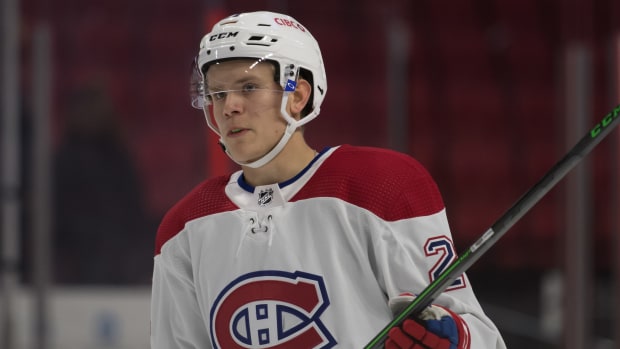Welcome to another edition of Screen Shots, a regular THN.com feature in which we tackle a few hockey topics in smaller reading portions. Once again, we’ll forget about taking too much time for an introductory paragraph, and get right to business:
– The Montreal Canadiens’ youth movement continues to start the 2022-23 NHL regular season, with youngsters Juraj Slafkovsky, Kaiden Guhle, Arber Xhekaj and Jordan Harris all reportedly on the Habs’ opening-night roster. If you include off-season trade acquisition Kirby Dach (21 years old), and youngsters Cole Caufield (21) and Emil Heineman (20) in the mix, that gives the Canadiens a whopping seven players between 18 and 21 years of age, and nine players between 18 and 24, although Logan Mailloux, 19, is expected return to junior once he’s cleared from injury.
We knew, heading out of last season and into this new one, that Montreal was embarking on a long-term rebuild – and by the time GM Kent Hughes deals away veteran forwards Sean Monahan and Evgeni Dadonov during the year, the Canadiens’ roster is likely to get even younger.
Going with up-and-comers is the safest route to eventually deliver the Habs into the playoff picture, but this season is going to be a what-have-we-got weigh station for the organization at the moment, and that almost assuredly is going to result in a bumpy competitive road for them. Canadiens fans are a sophisticated bunch, and they’ve known for a while now that this road was right in front of them, so they’re not going to be surprised by this. But pain is still going to be coming.
– The NHL’s end-of-pre-season waiver wire yielded some intriguing results over the Canadian holiday weekend, including the Arizona Coyotes claiming former Nashville goalie Connor Ingram and former Calgary Flames defenseman Juuso Valimaki. Both players are still young – Valimaki is 24, while Ingram is 25 – and, given Arizona’s status as a transparent tanker of a team, it’s entirely possible both of them could be gone before season’s end.
However, for the moment, Ingram and Valimaki have before them as solid a shot at establishing themselves as legitimate NHL contributors as they’re likely to get. Potential trade partners for their services may acquire them only as depth assets or short-term injury replacements, so they need to make the most of the opportunity they’re about to get with the Coyotes.
The only problem, of course, is they’re being asked to perform like keepers on a ‘Yotes roster that doesn’t have nearly enough keepers. But if they’re judged as individuals, both could lock up a place for themselves over the long haul with Arizona.
– Elsewhere on the NHL transactions front, we saw a handful of teams take short-term, low-risk-decent-reward gambles on veteran forwards: the Toronto Maple Leafs signed worker bee forward Zach Aston-Reese to a one-year, $840,000 contract. Their Atlantic Division rivals in Ottawa signed journeyman forward Derick Brassard to a one-year, $750,000 deal, and the New York Rangers signed forward Jimmy Vesey to a one-year, $750,000 pact. All three players had been in their respective training camps on professional tryout contracts, and the trio impressed enough to stick with their NHL team, at least, for now.
But they’re the exceptions to the rule: by and large, most teams cut ties with players in camp on PTOs, including defensemen Jason Demers (released by Edmonton), Ben Harpur (Columbus), and Matt Bartkowski (New York Rangers), and forwards James Neal (Columbus), Sonny Milano and Cody Eakin (both with Calgary) and Tyler Pitlick (St. Louis).
This is now the circle of life for players at or approaching the very end of their NHL days. Unless they’re locked into team-friendly contracts through the end of their thirties, many players must prove they’re still NHL-worthy, and because teams are committing so much salary cap space on youngsters, the veterans have little to no choice in what they can command, money-wise. It’s a reversal of the way things used to be prior to the cap; back then, players played for a relative pittance as young athletes, then cashed in with long-term contracts in their early thirties.
Some of these same players who did find a way to hang in as NHLers may face the waiver wire during the season, and they don’t have much say in where they’re going to be headed at that point in time, either. If they want to be on a competitive squad, they have to bite the bullet and take what is given to them, and while that is not entirely fair, that’s the reality.



